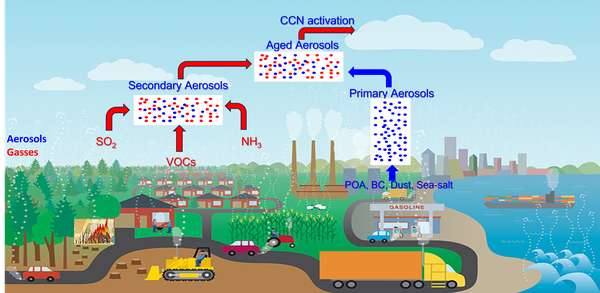Atmospheric Aerosol Modelling
ABOUT
Our research group investigates the prime role of atmospheric aerosol in shaping Earth’s climate and degrading air quality. An essential part of our mission is to develop innovative modelling tools to substantially advance the representation of the chemistry and physics involved in the aerosol formation and evolution in the atmosphere. In our studies we are utilizing these state-of-the-art modeling tools to provide an accurate assessment of the relationships between atmospheric aerosol, human-induced environmental changes, and future emission perturbations toward a sustainable environmental state.
RESEARCH TOPICS
- Tropospheric aerosol processes
- Aerosol-cloud-climate interactions
- Aerosol impacts on air quality
- Aerosol impacts on Earth's energy balance
Tropospheric aerosol processes

The scope of our research is to improve the representation of atmospheric aerosol formation, composition, properties, and size distribution in a chemistry climate model to accurately predict their global budget and lifecycle as well as their effects on global air quality. We specifically focus on advancing the description of organic aerosol formation and inorganic aerosol thermodynamics. We have developed a computationally efficient module for the description of organic aerosol composition and evolution in the atmosphere (ORACLE) which is currently implemented in the ECHAM/MESSy Atmospheric Chemistry (EMAC) model to simulate POA and SOA formation and growth. We also continue the development of advanced tools to accurately predict the aerosol thermodynamics and their impact on atmospheric composition and aerosol size distribution.
Our research covers the following areas:
- Increase the complexity of organic aerosol in atmospheric chemistry models
- Reformulate the treatment of aerosol partition between the gas and the aerosol phases
- Development of chemically speciated emission inventories
- Inorganic aerosol thermodynamics
- Dust-pollution interactions
- Heterogeneous chemistry of nitrate
Aerosol-cloud-climate interactions

The scope of our research is to improve the representation of aerosol-cloud interactions by continuing the development of advanced tools to accurately predict the formation of cloud droplet and ice crystals. Our focus lies on the impacts of atmospheric composition and chemistry interactions on cloud formation.
Our research covers the following areas:
- Simulate the ability of organic aerosol to absorb water and investigate its ability to act as cloud condensation nuclei
- Dust-pollution interactions and impacts on direct and indirect aerosol effects
- Develop new tools for calculating the phase state of organic aerosol
- Physically based cloud droplet and ice crystals formation parameterizations
Aerosol impacts on air quality

The development of comprehensive mathematical models can assist on improving our understanding of atmospheric aerosol lifecycle and its impact on regional and global air quality. After evaluation against observations, our modelling tools are used in the frame of a chemistry-climate model (EMAC) to give insights about the aerosol sources, formation pathways, and evolution (changes in composition and properties) during their atmospheric lifetime. Special attention is given on the interplay of natural (e.g., mineral dust, biogenic VOCs) and anthropogenic (e.g., fossil fuels, agricultural) sources.
Our research covers the following areas:
- Close the existing gaps between model predictions and observations for the major atmospheric aerosol components
- Identify missing sources and aerosol formation pathways from the current CCMs and improve our understanding of the underlying chemical processes
- Investigate how reductions of pollutant emissions can impact the air quality
- Determine how natural sources can impact the anthropogenic aerosol formation
- Investigate changes in the oxidative capacity of the atmosphere due to aerosol chemistry
- Unravel how the alkaline compounds can control the atmospheric aerosol acidity
Aerosol impacts on Earth’s energy balance

The Intergovernmental Panel on Climate Change addressed the need of reducing scientific uncertainties regarding the role of aerosols on climate change and identified indirect aerosol forcing of climate as the largest contributor to uncertainty in global climate modelling. Our modelling tools can be used to investigate these aerosol-chemistry-climate interactions and project how the composition of the atmosphere and the climate may change. The role of the mineral dust and organic aerosol components on the ability of atmospheric particles to absorb water, which is currently overlooked by climate models, is a major focus of our research.
Our research covers the following areas:
- Quantify how atmospheric aerosols can impact the climate in the future
- Explore the interactions of atmospheric pollutants with natural components and how does this influence their impacts on global climate
- Investigate the effects of organic aerosol photochemical aging on total aerosol hygroscopicity and radiative forcing
- Impacts of specific aerosol components on the resilience of the Earth’s energy balance and how they contribute to the calculated aerosol radiative forcing
- Effects of climate change mitigation strategies on the formation of specific aerosol components
Simulated Atmospheric Aerosol Composition


